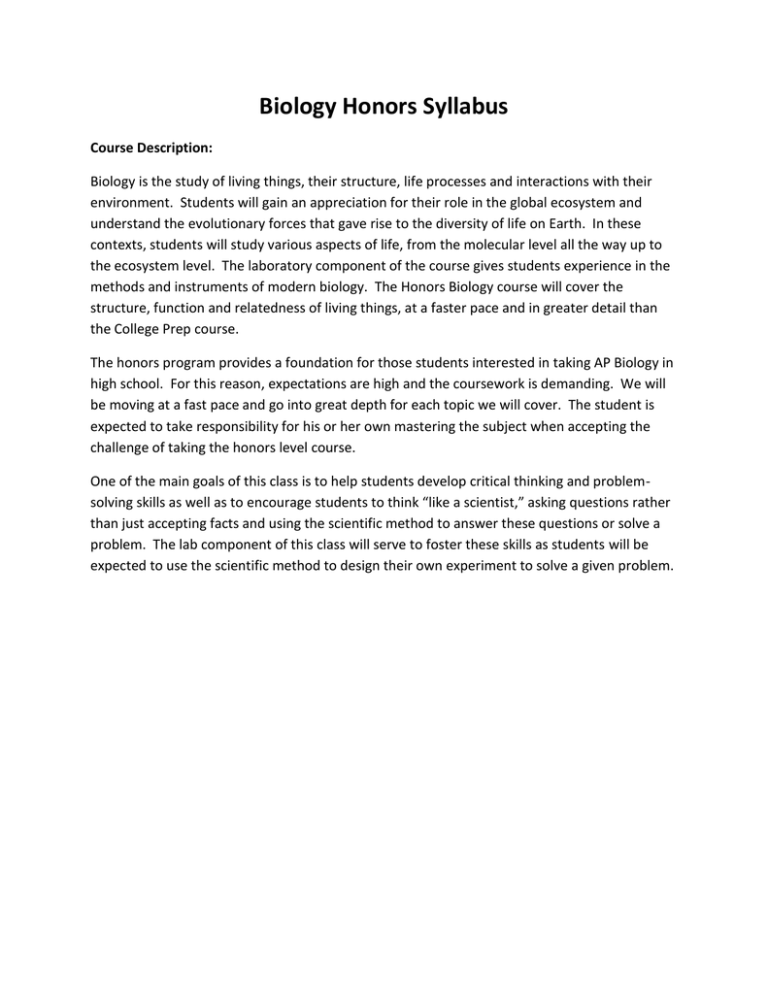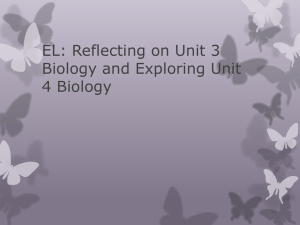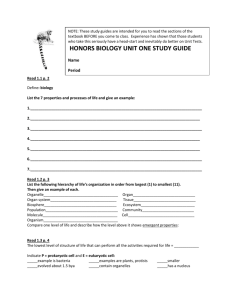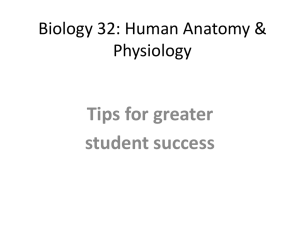Syllabus - Bio Honors
advertisement

Biology Honors Syllabus Course Description: Biology is the study of living things, their structure, life processes and interactions with their environment. Students will gain an appreciation for their role in the global ecosystem and understand the evolutionary forces that gave rise to the diversity of life on Earth. In these contexts, students will study various aspects of life, from the molecular level all the way up to the ecosystem level. The laboratory component of the course gives students experience in the methods and instruments of modern biology. The Honors Biology course will cover the structure, function and relatedness of living things, at a faster pace and in greater detail than the College Prep course. The honors program provides a foundation for those students interested in taking AP Biology in high school. For this reason, expectations are high and the coursework is demanding. We will be moving at a fast pace and go into great depth for each topic we will cover. The student is expected to take responsibility for his or her own mastering the subject when accepting the challenge of taking the honors level course. One of the main goals of this class is to help students develop critical thinking and problemsolving skills as well as to encourage students to think “like a scientist,” asking questions rather than just accepting facts and using the scientific method to answer these questions or solve a problem. The lab component of this class will serve to foster these skills as students will be expected to use the scientific method to design their own experiment to solve a given problem. Supplies Required - - A 3 ring binder with dividers A notebook dedicated to labs, such as a composition notebook - Paper, lined and graph Expectations - - - Students should come to class on time and prepared. Attendance and preparation is vital to success in class. Students are to participate in class and be respectful of others. Homework is expected to be done every day and turned in on time. Homework is meant to reinforce what is learned in class and prepare for the next day’s class. Late homework will not be accepted. In the case of absence, it is the students’ responsibility to see me to turn in homework checked in their absence and to collect and make up any missed homework. Failing to do so will result in loss of credit. Students are to produce their own, original work. This means no plagiarism, no copying work from other students and working independently unless otherwise permitted. Any evidence of any of the above will result in loss of credit. Skills Required Organizational skills: - Students are to keep an organized binder with papers kept in neat and chronological order Vocabulary words should be defined in a separate area of your binder. Index cards are strongly recommended. A strong knowledge of the vocabulary terms in Biology is extremely important in learning the subject. Study skills: - Tests and quizzes will be given frequently. There is a strong emphasis on assessment of progress. Vocabulary quizzes will be given frequently in order to keep up with the demands of this course. Lab skills: - - Students will participate in various labs throughout the year and they will learn the value of lab work in science. Biology is a lab course and lab investigations are a required component of Biology honors. Students must be in lab on time in order to get the most out of it. When absent with an excuse, it is the students’ responsibility to make up lab if and when it is possible. Unexcused absences will result in loss of credit with no opportunity to make it up. Students are expected to follow safety procedures as outlined in the lab safety contract. Failure to do so will result in not being allowed to participate in lab. Grading Procedure - Grades are based on a point system. Grades are calculated by taking the points that are earned and dividing by the total points available. Evaluation is based on the following (Please note that point values are subject to change): Tests: 100-150 points each Quizzes: 20-60 points each Lab reports: 10-20 points Homework checks: 5-10 points Various projects: Point values to be determined Text: Inquiry Into Life Helpful Resources: ConnectPlus Internet suite Contact Information: Email: mlevine@glenridge.org Phone: (973) 429-8300, ext. 2317 Note: Email is the easiest way to contact me and I will do my best to respond quickly to any questions or concerns. Course of Study I. Unit: Ecology Readings: Textbook chapters 33-37 Ecological interactions – biotic vs. abiotic Behavior ecology – innate vs. learned and the role of natural selection Population dynamics – growth and limitations/regulations Communities and ecosystems – energy flow, nutrient cycles, relationships and impact on evolution Biomes – climate and its effects on representative species, adaptations Human influences – positive and negative Topics: Activities: Observe ecological succession in a pond water ecosystem and determine the effect of changes in abiotic factors on the community. Design an experiment to test the effects of acid rain and detergent on seed germination. Study the growth characteristics of a yeast population. Model the affect of various abiotic factors and pollution on Eagle populations. Construct a model biome and describe characteristic climate and organisms and present “Identify the Biome” review game Create a food web using given lists of organisms II. Unit: Biochemistry Readings: Textbook: Chapter 2 Basic chemistry – atoms, bonding, reactions, Polarity of water and its importance to biological systems Carbon’s role in the molecular diversity of life Topics: Organic compounds – Form Fits Function in proteins, carbohydrates, lipids and nucleic acids Activities: Observe and distinguish physical and chemical changes. Determine the pH of common materials and relate them to relative acidity/alkalinity. Create an organizational chart to differentiate the four classes of organic compounds Identify organic compounds in foods by standard laboratory tests and identify the organic compound present in unknown solutions Construct molecular models of organic compounds, modeling dehydration synthesis and hydrolysis. Test the effects of temperature and pH on the effectiveness of enzymes III. Unit: Cell Structure and Function Readings: Textbook: Chapters 3-8 Prokaryotic vs. Eukaryotic cells – evolutionary connection Cell structures/organelles and function – protein factory The plasma membrane – Form Fits Function Modes of cellular transport – passive vs. active Mitosis and The Cell Cycle – significance of regulation Meiosis – sources of variation and inheritance Energy transformations – the roles of ATP, enzymes and redox reactions Photosynthesis – the chloroplast, the reactions and energy flow Cellular respiration – the mitochondria, aerobic vs. anaerobic respiration Topics: Activities: Prepare wet mount slides and conduct microscopic comparisons of plant and animal cells and their structures. Construct a model “plasma membrane” and observe the processes of osmosis and diffusion Design an experiment to test the permeability of plastic sandwich bags to various solutes, such as iodine, starch and glucose. Using phenolphthalein agar or potatoes, observe the relationship between diffusion efficiency and cell surface area. Separate and identify plant pigments using paper chromatography. Observe turgor and plasmolysis in plant cells with the aid of the microscope. Design an experiment to measure and record the effect of variables on the rate of photosynthesis using the spinach-leaf technique. Measure the release of energy from monosaccharides as indicated by temperature increase in a yeast culture. Observe the process of mitosis in prepared slides of plant and animal cells. Prepare and analyze slides of growing onion root tips to determine the relative amount of time cells spend in each phase of the cell cycle. Using yarn or bead “chromosomes,” model the processes of mitosis and meiosis and compare the genetic makeup of the daughter cells to that of the original cell. IV. Genetics Readings: Textbook: Chapters 23-26 Teacher-selected journal articles Mendel and his experiments in heredity – Patterns of inheritance Predicting genetic outcomes – Punnett squares, pedigree charts and karyotyping Gene linkage and mapping Mutations and chromosomal abnormalities – causes and results, evolutionary significance DNA structure – discovery, Form Fits Function and replication Protein synthesis – transcription and translation Regulation of gene expression – prokaryotic vs. eukaryotic Biotechnology and its applications o Recombinant DNA and GMO’s o DNA fingerprinting o Applications – industrial, medical, agricultural o Bioinformatics o Evolutionary significance Topics: Development of an organism from the embryo– regulation, role of gene expression and stem cells Activities: Use Punnett Squares to predict the outcome of monohybrid and dihybrid crosses. Use coins to simulate gametes and allelic segregation in one and two factor crosses. Analyze and create gene maps based on cross-over frequencies Extract DNA from common materials (kiwi, bacteria, strawberries, etc.). Using paper and/or bead models, simulate the processes of DNA replication, transcription and translation. Prepare a karyotype and examine it for genetic defects. Construct and interpret a human pedigree. Solve a hypothetical mystery using simulated blood typing. Complete web-based simulated lac operon activity. Prepare a recombinant paper DNA plasmid using restriction enzymes to produce sticky ends and DNA ligase to recombine the DNA fragments. Carry out gel electrophoresis of dyes to separate the mixed colors. Create a prezi presentation on the applications of DNA technology Create a genetics portfolio of the student and family, following family inheritance of various traits. V. Unit: Evolution Readings: Textbook: Chapter 27 Teacher-selected journal articles Darwin’s theory of evolution by natural selection and descent with modification Evidence for evolution – molecular and morphological analyses Microevolution – Hardy-Weinberg Laws of Genetic Equilibrium Macroevolution and Speciation – role of isolating mechanisms, molecular changes Phylogeny and systematics Topics: Activities: Construct a concept map outlining the formation of life on Earth and the early evolutionary steps Make “fossils” out of everyday items. Determine evolutionary relationships among diverse organisms based on amino acid sequence in hemoglobin and cytochrome c. Prepare and observe coacervates and microspheres. Research/Writing assignment: “Guess Who’s Coming to Dinner” Given a set of environmental conditions, create a fictitious organism and describe the adaptations it has developed to survive in its environment Predict and observe changes in allelic frequencies in model gene pools based on selective pressures. Use the Hardy-Weinberg equation to predict genotype and phenotype frequencies in future generations of a given population. Design and conduct an experiment to measure allelic frequencies of a plant population and its evolution Construct a phylogenetic tree based on genetic changes and divergences as determined by chance selections VI. Unit: Diversity of Life Readings: Textbook: Select sections of chapters 28, 29, 30, 31, 32, 12, 14, and 15 Basic characteristics and evolutionary history of bacteria, viruses, protists, fungi, plants and animals Primate evolution – from the earliest hominids to modern humans Human systems – the digestive, cardiovascular and respiratory systems Topics: Activities: View the presentation: “Walking with Cavemen” and answer question sets. Research the mechanisms by which HIV and other human viruses infect cells. Investigate the effectiveness of antibacterial soaps against common hand bacteria. Microscopically examine and identify representative protists. Examine mushrooms and bread mold using stereoscopes and microscopes. Dissect a variety of flowers and identify parts. Create a pamphlet/brochure on the different types of plants Dissection of a fetal pig, examining the digestive, cardiovascular and respiratory systems. Measure vital capacity of students’ lungs. Observe prepared slides of blood cells. Perform simulated blood typing. Measure blood pressure and heart rates of students.





